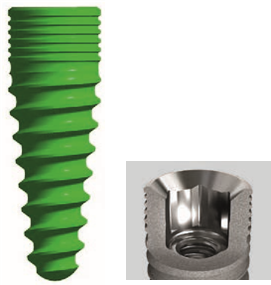
Implant Systems


BEGO RS/RSX Line (with Platform Switch)
Minimal bone loss around a dental implant is one of the fundamental design objectives when developing dental implants. According to Frost‘s theory [2], which is widely accepted in the field of biomechanics, bone loss is linked to unphysiological overloading at the point where the implant enters the bone. To avoid overloading, the BEGO Semados® RS/RSX-Line boasts a number of design features:
The implants in the RS/RSX-Line display a conical implant body. The implant body is equipped with a self-tapping, bionic thread. The bionic thread reduces the mechanical loading on the implant body and is advantageous for the surrounding bone.
The implant-abutment connection was designed employing the tried-and-tested principle of the 45° cone. The 45° cone allows biomechanically advantageous transmission of forces from the abutment to the implant. At the same time, no micro-gap appears when subjected to physiological loading.
The RS/RSX implants feature platform switching of 0.25 mm. The platform switching reduces the loading peaks in the bone along the bone margin. However, platform switching is only effective if the bone is no more than 0.5 mm below the level of the platform switching. If the bone recedes, the platform switching is not biomechanically effi cient. To keep the bone loading low in cases of very low bone recession, the implant neck is furnished with bionic microgrooves (patent pending, not yet published). The microgrooves reduce the stress peaks along the bone margin and along the tips of the microgrooves at the same time. This makes it possible to reduce stress in the bone considerably, even if the bone recedes below the level of the platform switching.
BEGO Semados SC/SCX Line (with Platform Switch)
A parallel sided implant for all bone qualities. Standard v-shape self tapping threads provide good stability. The reducing thread depth around the neck is achieved by expanding the core diameter, whilst maintaining the outer diameter to reduce stress and maintain marginal bone. This is in addition to the moderately roughened surface and an implant interface, which more than matches the strength of similar implants. The interface consists of a deep internal hex, along with an internal 45degree cone, which provides resistance to horizontal forces and maintains the integrity of the micro-gap.
BEGO Semados RI-Line (with Platform Switch)
The Semados RI-Line is identified by its condensing thread profile and unique patented shape. This design enables excellent primary stability even in poor quality bone. Although technically more demanding, it is particularly helpful in providing high torque insertion and mechanical stability for immediate implant restoration. The laterally aligned threads adapt accurately to the pre-formed osteotomy and assist ease of insertion.
The Semados RI-Line has the same reducing thread diameter around the neck of the implant and moderately roughened surface, as for other Bego Implant lines, providing marginal bone stability. The implant/abutment interface is also the same and so the same range of prosthetic components is suitable for all designs.
BEGO Semados Provisional Implant System
The BEGO Semados® provisional implants (PI-Line) are used for the temporary treatment of large augmented regions and based on the insertion of regular implants. Furthermore, they are suitable for fixation of mucosa-supported drill templates in the edentulous jaw.
For full details of all BEGO Implant designs, visit:
https://www.bego.com/implantology-solutions/implant-range/

